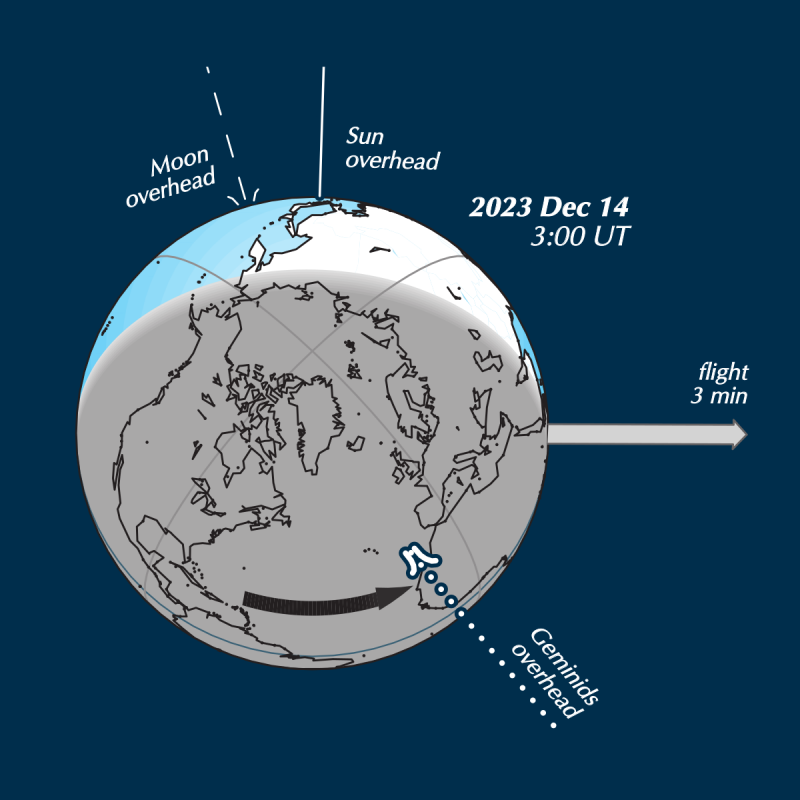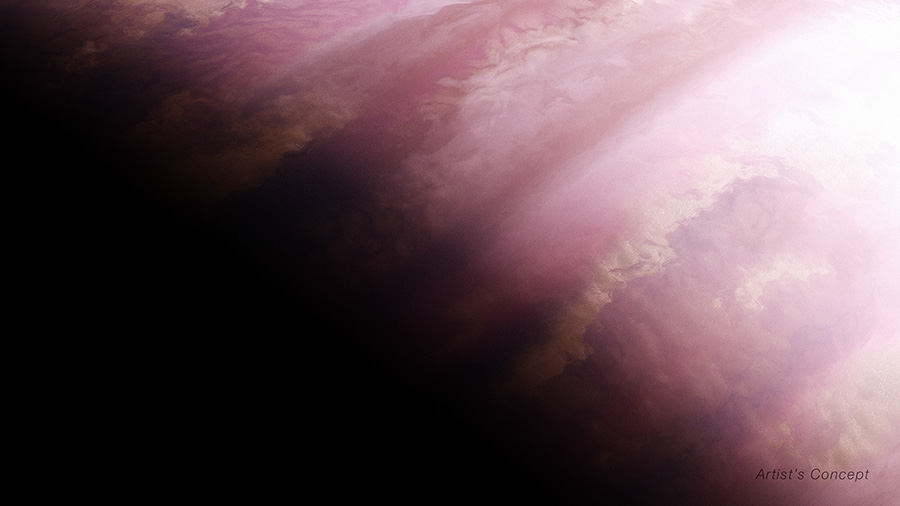Predicted peak: is predicted**19:27 UTC on December 14, 2023. But the night of December 13 might be good as well.
When to watch: Since the radiant rises in mid-evening, you can watch for Geminids from late night to dawn around the peak dates of December 13 and 14. Good news … a young waxing crescent moon sets in early evening and will not interfere with the Geminids in 2023.
Overall duration of shower: November 19 to December 24.
Radiant: Rises in mid-evening, highest around 2 a.m. See chart below.
Nearest moon phase: In 2023, the new moon fell on December 12. So there will be a dark sky during the peak of the 2023 Geminid meteor shower.
Expected meteors at peak, under ideal conditions: Under a dark sky with no moon, you might catch 120 Geminid meteors per hour.
Note: The bold, white, bright Geminids give us one of the Northern Hemisphere’s best showers, especially in years when there’s no moon. They’re also visible, at lower rates, from the Southern Hemisphere. The meteors are plentiful, rivaling the August Perseids.
Report a fireball (very bright meteor) to the American Meteor Society: It’s fun and easy!
The 2024 lunar calendars are here! Best Christmas gifts in the universe! Check ’em out here.
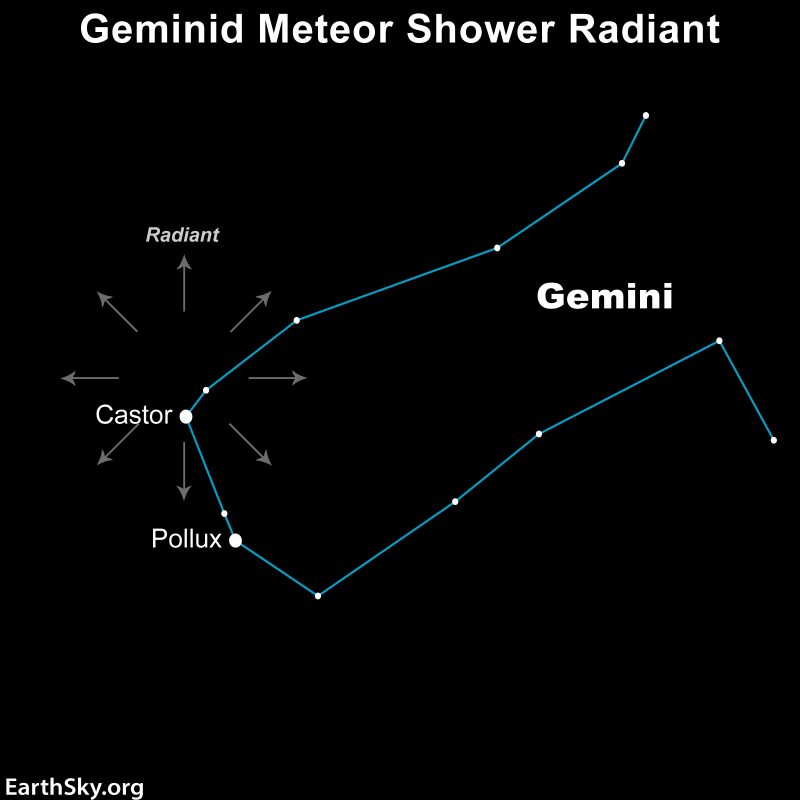
Geminid meteor shower parent comet
From the late, great Don Machholz (1952-2022), who discovered 12 comets …
An asteroid known as 3200 Phaethon is responsible for the Geminid meteor shower. This differs from most meteor showers, which result from comets, not asteroids. What’s the difference between a comet and an asteroid?
A comet is a dirty snowball, with a solid nucleus covered by a layer of ice which sublimates (turns from a solid to a gas) as the comet nears the sun. Comets are typically lightweight, with a density slightly heavier than water. They revolve around the sun in elongated orbits, going close to the sun, then going far from the sun. Seen through a telescope, a comet will show a coma, or head of the comet, as a nebulous patch of light around the nucleus, when it gets close to the sun. But when seen far from the sun, most comets appear star-like, because you see only the nucleus.
An asteroid is a rock. Typically, an asteroid’s orbit is more circular than that of a comet. Through a telescope an asteroid appears star-like.
These definitions worked well until a few decades ago. Larger telescopes began discovering asteroids far from the sun, and some of these objects, as they approached the sun, grew comas and tails, requiring the change of designation from asteroid to comet. For example, an odd object named Chiron, considered an asteroid when discovered in 1977, was reclassified as a comet in 1989 when it showed a coma. It orbits the sun every 50 years and travels from just inside the orbit of Saturn to the orbit of Uranus.
So an object initially considered an asteroid can be reclassified as a comet. Then, can the opposite occur? Can a comet be reclassified as an asteroid? Yes, it can. It is possible that a comet can shut down when its volatile materials become trapped beneath the nucleus’ surface. This is known as a dormant comet. When the comet loses all of its volatile materials, it is known as an extinct comet. The asteroid 3200 Phaethon seems to be an example of either a dormant or an extinct comet.
3200 Phaethon discovered in 1983
3200 Phaethon was discovered on images taken by IRAS (Infrared Astronomical Satellite) on October 11, 1983, by Simon Green and John Davies. Initially named 1983 TB, it was given an asteroid name, 3200 Phaethon, in 1985. After the orbit was calculated, Fred Whipple announced that this asteroid has the same orbit as the Geminid meteor shower. This was very unusual, since an asteroid had never been associated with a meteor shower. It is still not known how material from the asteroid’s surface, or interior, is released into the meteoroid stream.
3200 Phaethon gets very close to the sun, half of the distance of the innermost planet, Mercury. Then it ventures out past the orbit of Mars. So the meteor material intersects Earth’s orbit every mid-December, hence the Geminid meteor shower.
The Japanese spacecraft DESTINY+ (Demonstration and Experiment of Space Technology for Interplanetary Voyage with Phaethon Flyby and Dust Science) is expected to be launched in 2024 to visit the asteroid in 2028. One proposal from 2006 suggested crashing an object into 3200 Phaethon to produce an artificial meteor shower to better study the asteroid. DESTINY+, however, will not be hitting the asteroid.
But the particles from the asteroid will hit our atmosphere and you can see them this December.
Read more about asteroid Phaethon
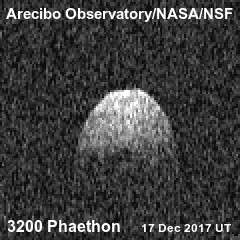
2023 Geminid meteor shower and the moon
The Geminid meteor shower – always a favorite among the annual meteor showers – is expected to peak in 2023 on the morning of December 14. The Geminids are a reliable shower for those who watch around 2 a.m. your local time from a dark-sky location. We also often hear from those who see Geminid meteors in the late evening hours. This year, a very young waxing crescent moon will set early in the evening and before the radiant rises. So you’ll have dark skies for viewing the meteor shower on those peak nights and mornings.
Geminid meteors tend to be bold, white and quick. Astronomer Guy Ottewell agrees these meteors tend to be bright. He offered this insight on his blog:
The Geminids, deriving from an asteroid rather than a comet, must include rock-sized pieces, which as they burn up in the atmosphere are often bright and do not leave trails.
He also said:
Following approximately the asteroid’s orbit, they cross inward close over Earth’s orbit almost sideways, from only slightly to the front, and slightly to the north. They appear to come at us from near Castor in the constellation of the Twins, and from this ‘radiant’ point their paths streak to any part of the sky. The radiant is up for almost all of the long (northern) winter night, highest at 2 a.m.
How many meteors, when to look
The zenithal hourly rate for this shower is 120. But you probably won’t see that many. On a dark night, near the peak of the shower around 2 a.m. (for all time zones), you can often catch 50 or more meteors per hour. During an optimum night for the Geminids, it’s possible to see 120 meteors – or more – per hour. So with dark skies in 2023, you might be treated to a great show.
By the way, this shower favors Earth’s Northern Hemisphere, but it’s visible from the Southern Hemisphere, too. The curious rock comet called 3200 Phaethon is the Geminids’ parent body.
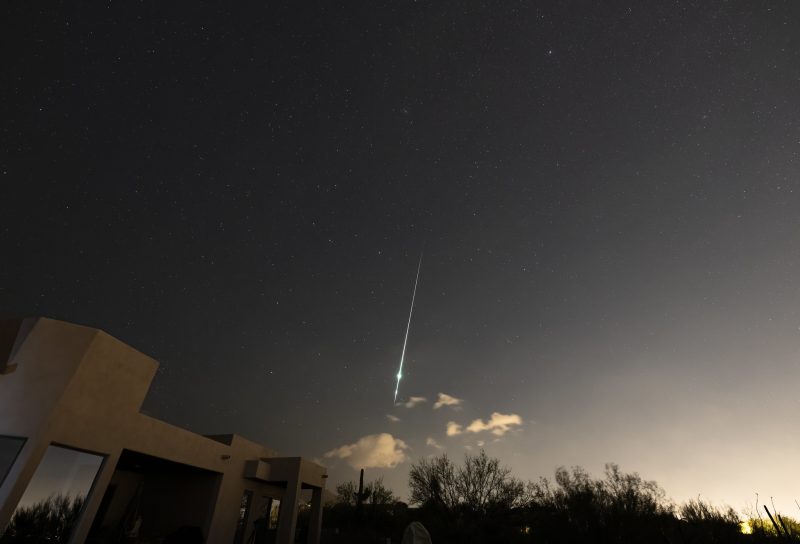
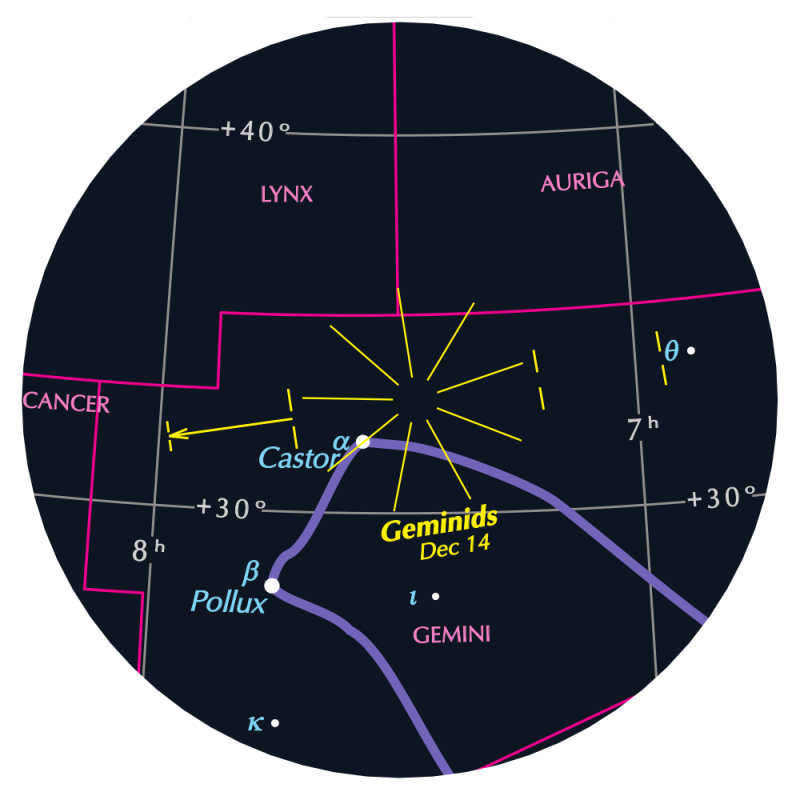
Geminid meteor shower radiant point
The Geminid meteor shower is best around 2 a.m. your local time because its radiant point – the point in our sky from which the meteors seem to radiate – is highest in the sky at that time. Generally, the higher the constellation Gemini the Twins climbs into your sky, the more Geminid meteors you’re likely to see.
The Geminids’ radiant point nearly coincides with the bright star Castor in Gemini. That’s a chance alignment, of course, as Castor lies about 52 light-years away, while these meteors burn up in the upper atmosphere some 60 miles (100 km) above Earth’s surface.
Castor is noticeably near another bright star, the golden star Pollux of Gemini. It’s fun to spot them, but you don’t need to find a meteor shower’s radiant point to see these meteors.
The meteors in annual showers appear in all parts of the sky. It’s even possible to have your back to the constellation Gemini and see a Geminid meteor fly by.
6 tips for Geminid meteor watchers
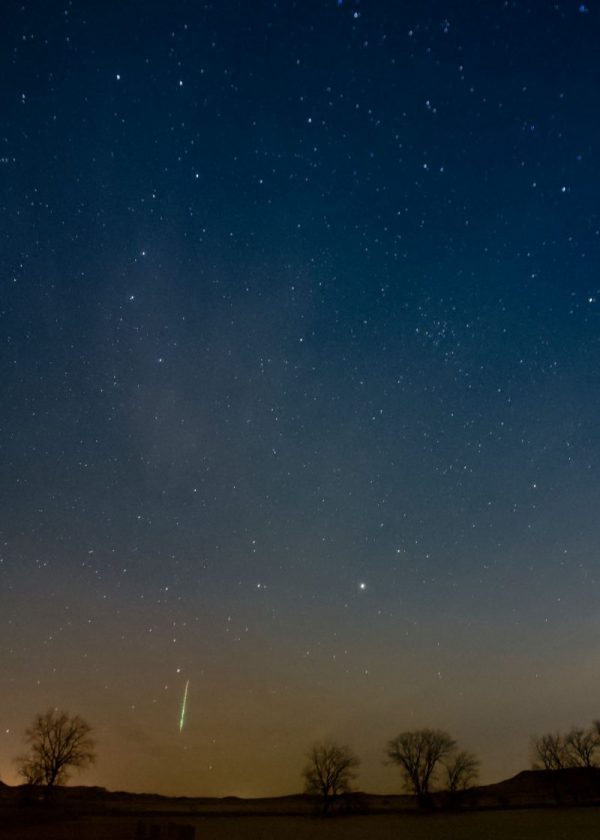
1. The most important thing, if you’re serious about watching meteors, is a dark, open sky.
2. The peak time of night for Geminids is around 2 a.m. for all parts of the globe. In 2023, a thin waxing crescent moon will set in the early evening, so you will have dark skies for viewing the meteor shower. Visit Sunrise Sunset Calendars to find moonset times (be sure to check the moonset times box) for your specific location.
3. When you’re meteor-watching, it’s good to bring along a buddy. Then the two of you can watch in different directions. When someone sees one, call out, “Meteor!” This technique will let you see more meteors than one person watching alone will see.
4. Be sure to give yourself at least an hour (or more) of observing time. It takes about 20 minutes for your eyes to adapt to the dark.
5. Be aware that meteors often come in spurts, interspersed with lulls.
6. Special equipment? None needed. Maybe bring a sleeping bag to keep warm. A thermos with a warm drink and a snack are always welcome. Plan to sprawl back in a hammock, lawn chair, pile of hay or blanket on the ground. Lie back in comfort, and look upward. The meteors will appear in all parts of the sky.
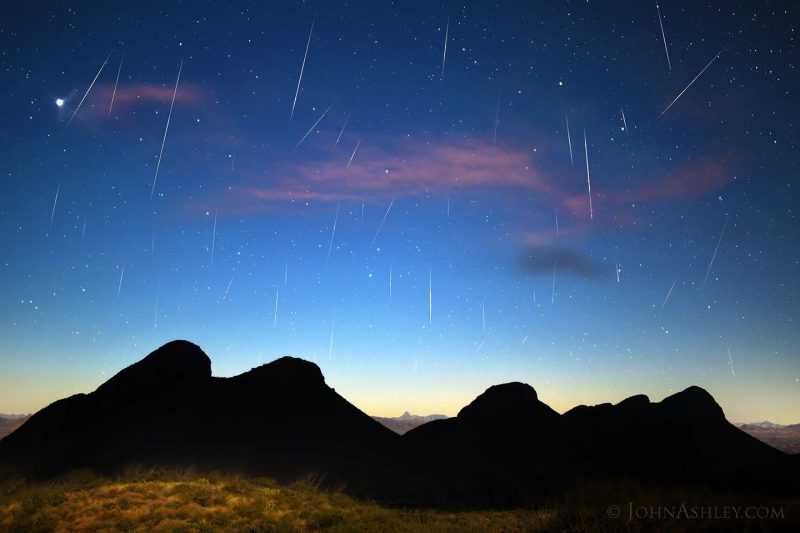
Watch for earthgrazers in the evening hours
If the 2 a.m. observing time isn’t practical for you, don’t give up! Sure, you won’t see as many Geminid meteors in the early evening, when the constellation Gemini sits close to the eastern horizon, but since the radiant rises mid-evening it’s worth a try. Plus, the evening hours are the best time to try and catch an earthgrazer.
An earthgrazer is a slooow-moving, looong-lasting meteor that travels horizontally across the sky. Earthgrazers are rare but prove to be especially memorable, if you should be lucky enough to catch one.
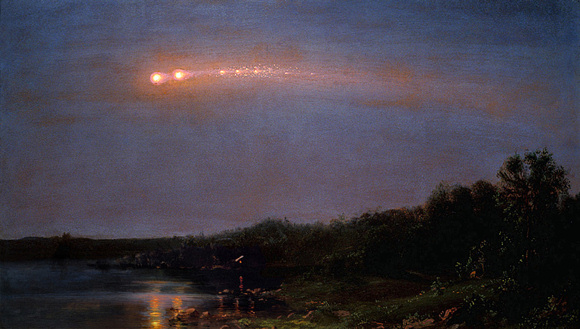
Bottom line: The 2023 Geminid meteor shower peaks December 14 under dark skies. You may see up to 120 meteors per hour.
**Predicted peak times and dates for 2023 meteor showers are from the American Meteor Society. Note that meteor shower peak times can vary.
Meteor showers: Tips for watching the show

